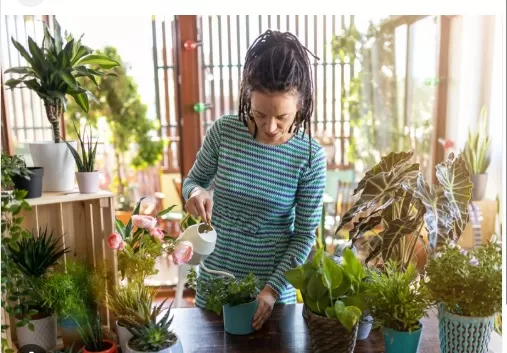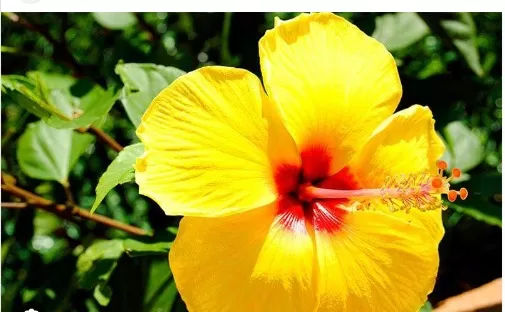Indoor Winter Plants: 5 Species for Year-Round Greenery. To ensure the survival and future growth of cold-tender landscape plants, employing effective overwintering strategies is essential. By implementing these techniques, you can protect your plants during the harsh winter months and set the stage for their flourishing comeback in the following year.
Preserving Healthy Plants: The Benefits of Bringing Them Indoors for Winter

Many gardeners delight in showcasing their houseplants outdoors during the summer months and then bringing them indoors for the remainder of the year.
However, an intriguing question arises: why not apply a similar strategy to save money while ensuring the vitality of your favorite cold-tender plants? By sheltering them indoors when the temperatures drop, you can ensure they thrive and dazzle once again when summer returns.
Preparing your outdoor plants for winter necessitates a few essential steps.
First and foremost, thoroughly inspect them for pests and take appropriate measures to address any infestations. Additionally, consider repotting plants that require it and adjust your fertilization routine accordingly, reducing or eliminating it as needed.
Depending on the specific plant species, some can be effortlessly transitioned into houseplants, while others benefit from being induced into dormancy for a few months of cool storage. There are also certain plants that can be propagated through rooted cuttings to maintain their growth.
.
In this article, we will explore 10 popular cold-tender plants that you can bring indoors each winter, allowing you to enjoy their beauty outdoors for many summers to come.
By understanding the unique requirements of these plants and learning how to effectively care for them during the winter months, you can successfully preserve their health and ensure their longevity. Embracing this approach not only allows you to protect your investments in these cherished plants but also adds a touch of greenery and vibrancy to your indoor space throughout the colder seasons.
Caring for Palms: Overwintering Tips for a Lush Indoor Paradise
Although certain palm tree varieties can withstand the winter conditions of the Deep South, the majority of palms thrive best when brought indoors for the colder months.
Leaving them exposed to freezing weather can be detrimental to their health and vitality. When nighttime temperatures begin to dip into the 50s, it’s time to take action by relocating your cherished palms to a well-lit indoor space. By following a few essential guidelines, you can ensure their well-being and prepare them for a triumphant return to the outdoors once the threat of frost has subsided.
One crucial aspect of palm care during the winter is consistent watering.
It’s important to keep the soil moist by watering your palms regularly. This helps to mimic the natural moisture levels they would typically receive outdoors.
Be mindful not to overwater, as excessive moisture can lead to root rot. Finding the right balance is key to maintaining their health throughout the winter months.
While indoors, ensure that your palms receive ample light.
Place them in a location that receives plenty of natural sunlight or provide supplementary artificial lighting if necessary. Palms thrive in bright, indirect light, and providing them with adequate illumination will help them maintain their lush, green foliage.
Once spring arrives and the threat of frost has passed, it’s time to transition your palms back outdoors.
Gradually acclimate them to the outdoor environment by placing them in a shaded or protected area at first. As they adjust to the outdoor conditions, gradually expose them to more direct sunlight.
This gradual process will prevent shock and allow your palms to thrive once again in the great outdoors.
By following these simple steps and providing the necessary care, you can ensure the longevity and beauty of your palm trees.
Bringing them indoors for the winter not only protects them from the harsh elements but also grants you the opportunity to create an indoor paradise filled with lush greenery. So, embrace the joy of overwintering your palms and enjoy their splendor year after year.
Embracing the Dormancy of Cacti: Maximizing Health through Winter Care

When it comes to caring for cacti and succulents during the winter months, it’s essential to take advantage of the natural cues provided by shorter days and cooler nights.
By leaving them outdoors for as long as possible, you can stimulate a dormancy response that promotes their overall well-being. However, it’s crucial to be mindful of the low temperature threshold for your specific type of cactus, as not all species can withstand the same levels of cold.
While some cacti can endure temperatures as low as 20 degrees Fahrenheit (-6 degrees Celsius), others are more sensitive. Understanding the needs of your cacti will help you provide the best care.
In general, cacti thrive in cool, well-lit environments during the winter months.
Look for a location that remains cool, or even unheated, while providing ample brightness. This could be a bright window sill, a sunroom, or a greenhouse.
Avoid areas with excessive heat or fluctuating temperatures, as these conditions can disrupt their dormancy and hinder their growth. Additionally, it’s important to limit watering during this period.
Cacti have adapted to survive in arid conditions, so they require minimal water during their winter rest. Overwatering can lead to rot and other complications.
Instead, only provide small amounts of water when the soil has completely dried out.
Keeping a close eye on the thermometer is crucial to protect your cacti.
Monitor the temperature regularly and be aware of any impending cold spells or frost. If the temperature is expected to drop below the tolerance level of your cacti, it’s time to take action.
Bring them indoors to a sheltered location or provide additional protection such as covering them with frost blankets or moving them to a garage or shed. The goal is to shield them from extreme cold and prevent any damage.
As spring approaches and the danger of frost diminishes, it’s time to transition your cacti back outdoors.
Gradually reintroduce them to the outdoor environment by placing them in a partially shaded area at first. Over the course of a few weeks, gradually increase their exposure to direct sunlight.
This acclimation process will help them adjust to the changing conditions and prevent sunburn or shock.
By embracing the dormancy of your cacti and providing appropriate care, you can ensure their health and longevity.
Maximize their potential by allowing them to experience their natural cycle of rest and growth. So, keep an eye on the temperature, provide a cool and bright winter location, limit watering, and transition them back outdoors with care.
With these steps, your cacti will continue to thrive and bring joy for years to come.
Nurturing Citrus Trees: Winter Care for Fruitful Delights
Citrus trees possess the remarkable ability to thrive and bear fruit during the winter season.
To ensure their continued growth and bountiful harvest, it’s important to take proactive steps and provide the right care. As freezing weather approaches, it’s crucial to carefully relocate your citrus trees to a well-lit indoor space, ideally maintaining a temperature between 55 and 70 degrees Fahrenheit (13 to 21 degrees Celsius). By following a few key guidelines, you can create an optimal environment for your citrus trees to flourish.
When selecting an indoor location for your citrus trees, it’s important to consider their sensitivity to air moisture.
Position them away from heat vents and cold drafts, as these can cause the air to become dry, negatively impacting the plants. Instead, choose a spot that provides adequate bright light and stable temperatures.
A sunny window or a room with sufficient artificial lighting can serve as an ideal home for your citrus trees during the winter months.
To counterbalance the drying effects of indoor heating systems, it’s beneficial to provide supplemental humidity for your citrus trees.
One method is to place a pebble tray filled with water beneath the plants. As the water evaporates, it increases the humidity levels around the trees.
Alternatively, you can regularly mist the foliage with water to simulate a humid environment. These measures help to prevent excessive moisture loss and maintain the health of the trees.
While caring for citrus trees indoors, it’s important to continue their regular watering routine.
Keep the soil consistently moist but avoid overwatering, as excessively wet conditions can lead to root rot. Allow the soil to partially dry out between waterings, and adjust the frequency based on the specific needs of your citrus trees.
Regularly check the moisture level of the soil by inserting your finger about an inch deep into the soil. If it feels dry at that depth, it’s time to water.
With proper care and attention, your citrus trees can thrive indoors throughout the winter season, continuing to grow, flower, and even ripen fruit.
By providing a well-lit space, maintaining appropriate temperatures, and ensuring sufficient humidity, you can enjoy the beauty and deliciousness of citrus in your home. So, embrace the joy of nurturing your citrus trees during winter and savor the rewards of their fruitful delights.
Embracing the Beauty of Tropical Hibiscus: Winter Care for Vibrant Blooms

When the mercury begins to dip and overnight temperatures reach the low 50s, it’s time to bring your tropical hibiscus plants indoors to ensure their continued growth and blooming.
By following a few essential steps, you can create a favorable environment for these stunning plants to thrive throughout the winter season. Let’s explore the key aspects of caring for tropical hibiscus during this time.
Find a brightly lit room within your home to accommodate your tropical hibiscus plants.
They require ample sunlight, so a sunny window or a space with sufficient artificial lighting is ideal. Treat them as you would regular houseplants, ensuring they receive the necessary light for their growth and blooming.
While indoors, it’s crucial to maintain proper watering practices for your tropical hibiscus.
Keep the soil consistently moist, but avoid overwatering, which can lead to root rot. A good rule of thumb is to allow the top inch of soil to dry out before watering again.
By striking the right balance, you can provide the necessary hydration without drowning the plant.
Feeding your tropical hibiscus regularly is also important for its overall health and vigor.
Use a balanced fertilizer formulated for flowering plants and follow the instructions on the packaging. Regular feeding will provide the essential nutrients needed for vibrant blooms and lush foliage throughout the winter months.
When choosing a location for your tropical hibiscus, be mindful of heat vents and cold drafts.
These plants prefer stable temperatures and can be sensitive to extreme temperature fluctuations. Avoid placing them in the direct path of a heating source or in a drafty area to ensure their well-being.
Boosting ambient humidity can be beneficial for tropical hibiscus, especially in indoor environments with dry air.
A simple method to increase humidity is by placing the plants on a pebble tray filled with water. As the water evaporates, it creates a more humid microclimate around the plants.
Alternatively, you can mist the foliage regularly to provide additional moisture.
To maintain the desired shape of your tropical hibiscus plants, it’s recommended to prune them three times during the late fall and winter months.
Perform pruning sessions in October, December, and February, trimming back any leggy or overgrown branches. This helps promote a compact and well-shaped plant, ready to burst with blooms when warmer weather returns.
By following these winter care guidelines, you can continue to enjoy the vibrant beauty of your tropical hibiscus plants even during the colder months.
With proper lighting, watering, feeding, and pruning, your hibiscus will thrive as a stunning centerpiece in your indoor space. So, bring the tropical paradise indoors and delight in the splendor of tropical hibiscus all year round.
*The information is for reference only.